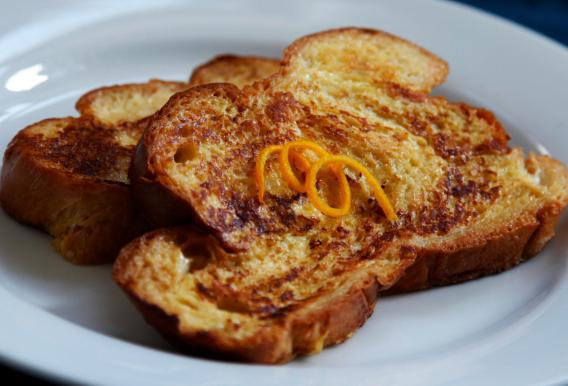Many of us learn how to make French toast at a young age. It’s a simple dish, and it gives many kids one of their earliest cooking experiences. Sadly, many of us never reconsider that kid-friendly recipe we learned at the age of six or seven. We simply return to it whenever we need to create a quick and inexpensive breakfast. (Or lunch. Or dinner. Don’t judge.)
To make truly great French toast, however, you need to break some old habits—and treat the recipe as you would one for a less familiar dish. Sometimes practice doesn’t make perfect.
French toast as we know it comes from a, yes, French dish called pain perdu, which means lost or wasted bread. It began as a way to use ingredients that were already on hand and might otherwise go to waste—as did several similar dishes, both sweet and savory, from around the world. That these dishes involve day-old bread reflects their roots in a time before our food got loaded with preservatives, when you had to buy bread every day if you wanted it to taste fresh. Much of the bread we eat today lasts longer, of course, making the original motivation for French toast obsolete for many. Ironically, achieving successful French toast often requires an extra trip to the bakery.
And what should you get when you make that trip? Preservative-free challah or brioche. Enjoy a few slices fresh with butter and jam the first day you buy it, then turn it into killer French toast the next day. These dense loaves, when dried out a bit, will hold onto your egg mixture without falling apart better than just about any other bread you’ll find.
As for the dairy, high-fat milk will, as always, deliver a richer result. Vanilla adds a nice kick—though almond extract, cinnamon, and brandy (or another liqueur) also work well. Lastly, fresh orange zest and orange juice offer a bright note that cuts through some of the richness.
The cooking process remains mostly what we’re all used to—with one extra step: straining the egg mixture. Have you ever been the unlucky recipient of that one piece of French toast that is almost entirely covered in egg white? No matter how long you beat together the egg and milk, there’s always some extraneous egg. Straining the mixture helps to keep every piece consistent.
Simple French Toast
Yield: 4 servings
Time: 20 minutes
6 large eggs
1¼ cups whole milk
¼ cup orange juice
1 teaspoon vanilla extract
Salt
1 teaspoon grated orange zest
4 tablespoons butter
Eight ½- to 1-inch slices day-old challah bread or brioche
Maple syrup and powdered sugar for serving
1. Whisk together the eggs, milk, orange juice, vanilla extract, and a pinch of salt in a large bowl. Strain the mixture to remove any egg that has not been fully incorporated, then whisk in the orange zest.
2. Melt ½ tablespoon butter in a large skillet over medium-high heat. Coat two slices of challah on both sides with the egg mixture and transfer them to the pan. Cook the first side until golden brown, about 2 minutes, then add another ½ tablespoon butter to the pan. When it’s melted, flip the bread and cook until golden brown on the second side, another 2 minutes or so. Repeat with remaining butter, bread, and egg mixture.
3. Serve hot or warm with maple syrup and powdered sugar, or any other desired toppings.
Previously in You’re Doing It Wrong:
Tofu
Cinnamon Rolls
Biscuits
Apple Chutney
Pancakes
Frittata
Granola
